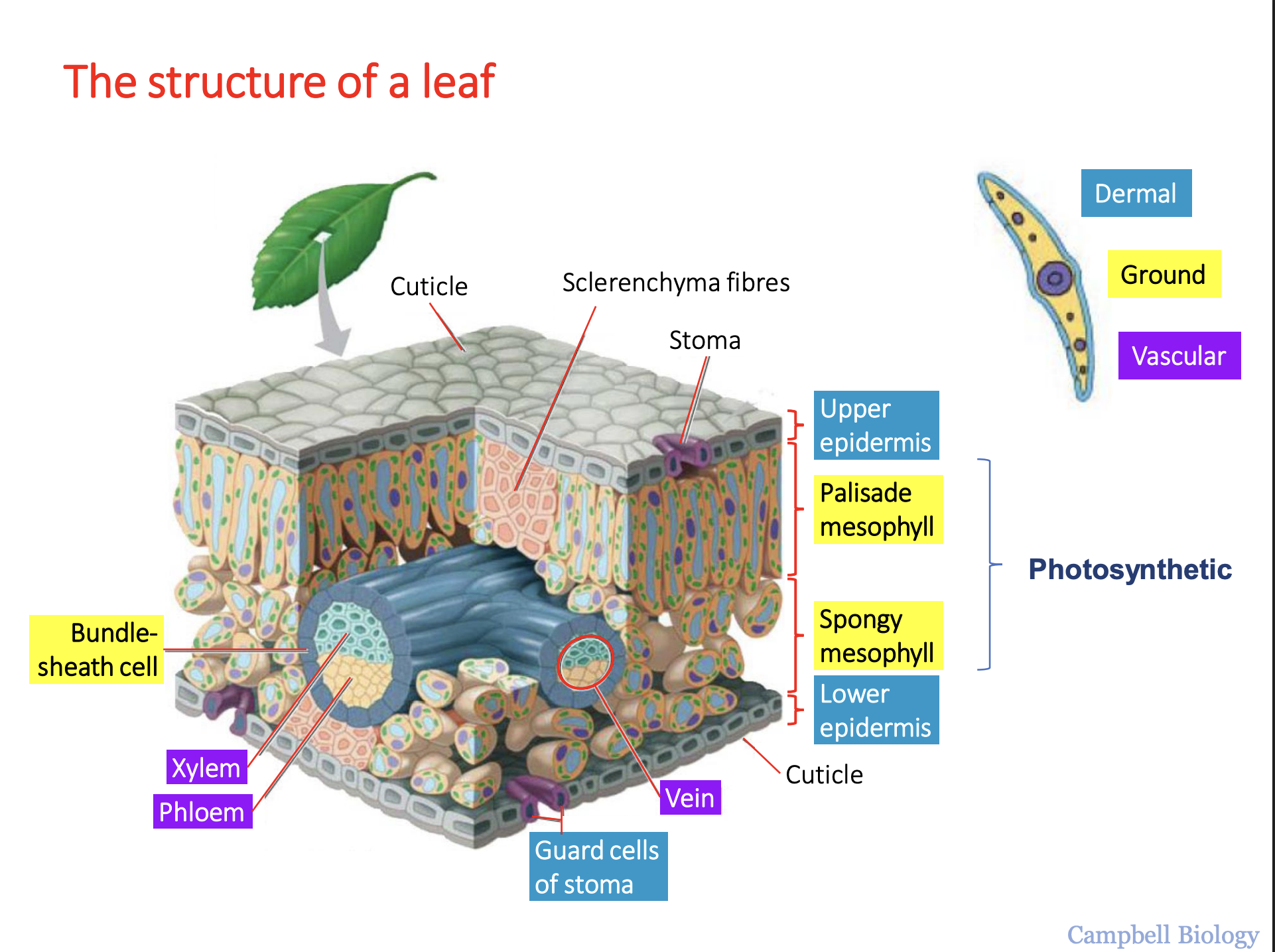Lectures 15: Gas exchange and transport in plants
1/7
There's no tags or description
Looks like no tags are added yet.
Name | Mastery | Learn | Test | Matching | Spaced |
|---|
No study sessions yet.
8 Terms
Name the three main tissue types in plants and provide a description of their
key functions
dermal layer(sometimes referred to as the epidermis) - provides protections, acts as a barrier between the inside of the plant and the outside environment - the stomata are the only photosynthetic part of the dermal layer
ground tissue - packs out the leaves and stems, provides support, tissue in which sugars are stored (providing a food supply for later) very similar to connective tissue
vascular tissue - runs througjt the leaves and throughjt the roots - takes water upwards (xylem) and sugars downwards (phloem)
Sketch the structure of a typical leaf, identifying the position of the main
photosynthetic cells

spongy mesophyll - lots of air space in between, lots of chloroplasts in them, photosynthetic, they get a bit of light coming through but some would have already been absorbed by the palisade layer
vascular bundles - bundle sheath cells support the vascular system and are part of the ground tissue
cuticle - protective layer that protects form water loss

Explain the role of the stomata in controlling the exchange of gases and
regulating water loss, providing a description of the process by which the
opening of the stomata is itself controlled
plants need to come to a balance where they can exchange gases but not allow the evaporation of water
epidermis prevents water loss but slows the exchange of gases - it is protective however, it acts as a barrier
Stomata - allow air in and out, allow water in and out - open and close in order to regulate transpiration - surrounded by guard cells
Xerophytes - adapted to reduce transpiration - pores tucked away to protect them from drying air - hair like structures to reduce the amount of water loss through evaporation
Control of the stomata by movement of K+ ions
Stomata open
in guard cells we have k+ pumps
pump k+ into vacuoles of these stomata
decreases water potential
therefore water enters via osmosis
causing the guard cells to become turgid
as the cells swell up and get turgid and they open up the stomata creating that pore like structure
What happens if the plant is dehydrated/not waterd
roots sence that ther’s no water and they make abscidic acid
this is transported to the leaves via the xylem which open the k+ exit channels
this increases the water potential because the k+ ions have gone out - when k+ passes out, so does the water via osmosis
guard cells become flaccid which makes them “flop” back into the middle and close the pore

understand and articulate how and why water is transported in plants
symplastic route - water enters the cells passing through cytoplasm of one cell into the cytoplasm of another (vacuolar route is when it also passes into the vacuoles)
apoplastic - water moves along only through the outer surfaces - within the cell walls and spaces
transpiration - water molecules leave through the stomata - the water is replaced from the film of water in the apoplast - it then moves form the air spaces out through the stomata - reduces the volume fo water - increases the surface tension - which pulls water out of the xylem
understand and articulate how and why organic compounds are transported
in plants
describe the physical processes behind these methods of transport
link the physical structure of plants and named cell types to these processes
as water moves through the xylem the cohesion and makes them stick together and the column
root pressure - where there is abun